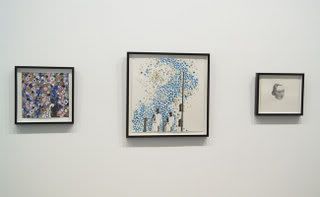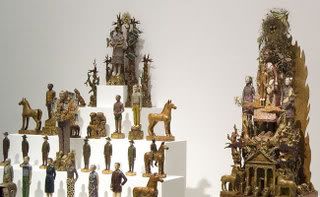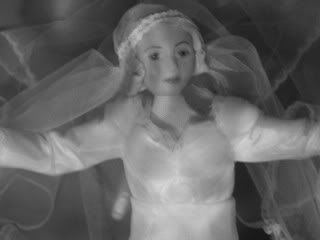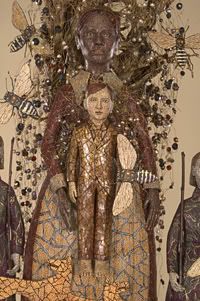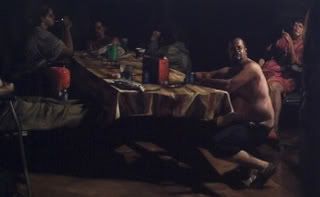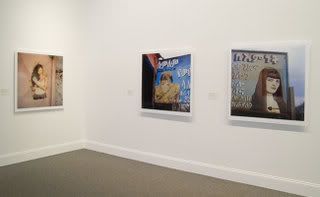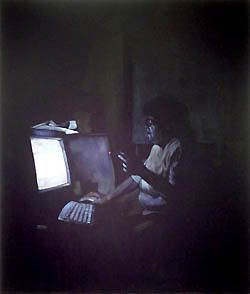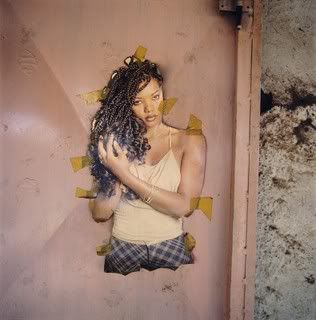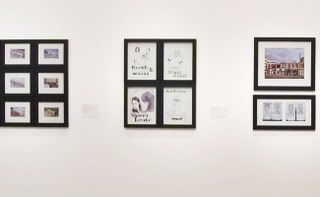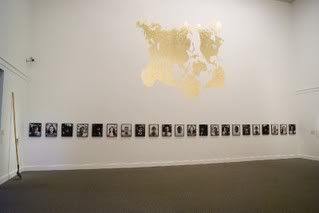Sondheim Finalist’s Exhibition at the Baltimore Museum of Art, from June 23 – August 5, 2007.
Cara: After viewing this exhibition and having a chance to speak with the artists, I have been recommending it to others, especially local artists. All seven finalists offer an intriguing glimpse into the world of contemporary art and reflect international trends still in their early stages. Besides a flirtation with social activism, the seven finalists couldn’t be more different. The show is a mish-mash: a combination of highly accomplished and emerging artists, of low tech and high, and a complete range of media, from drawing to installation to video.
Don: Were I to choose one image to encapsulate ALL of the works and artists gathered in this BMA exhibit, it would be David’s “Death of Marat” – that superb little painting which, at once acknowledges and exceeds its Neo-classical origins – and is a forceful rallying cry for Revolutionary action.
Don: “Classicism” is a common denominator that registered for me in the work of Yasinsky, Cleaver, Dyer, and Shore – namely, that each of them recover key motifs from the cultures of previous, dated generations, or the Western Canon and, to a greater or lesser degree, are successful in dovetailing that antique material into an engaging contemporary visual product. I don’t have a satisfactory tag for this common denominator – BUT it does set these artists apart from their immediate peers in the Sondheim exhibit – and from many of their larger world peers.
Jarrett: I don’t know if I agree with Don about a return to Classicism among the work presented at the BMA. I find Yasinsky and Cleaver related, Day and Shore related, Martinez and Grace related with Dyer sort of floating in between all of them.
Cara: I also saw several ‘pairings’ among the artists. Yasinsky and Cleaver’s works are most personal and most developed, Shore and Day are paired in the same gallery and both explore ‘abject objects,’ while Grace and Martinez are both attempting to address social wrongs in their work. I am not sure where Dyer fits into this scheme, since he pairs modern technology with an archaic form of animation – the zoetrope.
Don: Just to clarify, I’m not talking about traditional Western Classicism when referring to Yasinsky, Cleaver, Dyer, & Shore. I’m not entirely certain what sort of “Classicism” this is – perhaps the “Classicism” that comes out of High Modernism & its tangents; a sort of “Covert Classicism” that Reyner Banham alludes to in his writings on Modern Architecture and the Modernist experience in general…
Don: Karen Yasinsky is a strong personal favorite for all of us, particularly her film, “Jules & Juliette.”
Cara: I thought the most accomplished works in the show were by Cleaver and Yasinsky. Both have imbued their works with a ‘quietude’ that the viewer experiences as a guilty pleasure, rather than intellectually. Cleaver’s works are delicate and seductive because of the lavish surface detail, the secret compartments, and the unique features of each doll figure: he lovingly hides his secrets in these works. Cleaver transforms us into voyeurs, and we collude in his secrets. It’s very rich. He doesn’t need to convince us of anything.
Cara: Yasinsky’s works affected me the same way. Her series of small drawings on paper were simple and quiet, compared with the video projected in the next room. Domestic details, especially a focus on wedding and conjugal paraphernalia – lace, fabric, even curtains, take on dual roles and are paired against one another. Like Cleaver, Yasinsky’s works subtly portray the delight and tension in these interior worlds, and the viewer is an outsider, invited to look in on these private moments.
Don: Both Karen Yasinsky’s and Richard Cleaver’s works recover a kind of “Classicism,” in the sense that neither is fixated on motifs and cultural references within their own generation. I think we’re tired of work that depends on insider references to Seinfeld, Transformer Toys, or a particular generation’s pop music interests, etc. Instead, Yasinsky and Cleaver reach back 2 or 3 generations for key visual references – Yasinsky with her Cocteau-like atmosphere and rag-doll marionettes, and Cleaver with his faux-antique figures/statues and altar-like tableaus. It’s also interesting that both use some form of “doll” in their work – again, a look back to Surrealism’s “enchanted /perverse dolls,” and the larger theme of the “disquieting childhood.” Yasinsky and Cleaver are visually lush artists who have also deeply considered issues of gender roles and memory, but are interested in ways of making the visual expand to embrace and drive their experience and curiosity.
Jarrett: I think that Yasinsky’s and Cleaver’s work reaches beyond Classicism to the more naïve and instinctual methods of art making. Innocence, individuality and pure quirkiness are hallmarks of naïve art-making. I think more Art Brut, Surrealism or Folk Art rather than Classicism. Both artists rely on an engagement with the world THEY are creating rather than an overt concern with conveying a MESSAGE to the viewer. Mingled with the innocence of their sources is the vision and attention of mature artists. This is a potent combination in both bodies of work. The humor without overt cynicism is the other important component that makes this art very successful for me. There seems to be more cheeky knowingness rather than the outright jokiness of contemporary work.
Don: Eric Dyer also recovers a kind of “Classicism” in the way he fits together both antique and cutting edge viewing/animation technologies – the 19th Century Zoetrope meets 21st Century Digital Imaging. And while it’s admirable that he doesn’t discard the old in a rush to embrace the new, his particular portion of this exhibit seems too spare to capture the full richness of his efforts and inventiveness. In previous exhibitions, he’s displayed a number of the sculptural discs that are used to create his animated projections – and their absence here is a considerable loss.
Don: Likewise, Tony Shore, in his frequent allusions to Western Painting subjects (Van Gogh’s the “Potato Eaters” shows up most apparently in this exhibit) also recovers a “Classicism” in his work. And in this exhibit, Shore may have found the very best space to show his work – the BMA’s spacious walls allow the artist to make a dramatic visual flow of strong vertical and horizontal rectangular black “voids,” punctuated by moments of illumination. What Shore indulges, however, is a kind of “Retro” Classicism in both the references to Western Painting, and his own Baltimore working-class genre scenes – and this “retro styling” unfortunately places him in the larger “Retro-Pop” that has become so over-used and cloying in the larger visual culture, and has become a staple of Baltimore’s art scene.
Jarrett: I agree with Don about the Classicism of Shore’s work. We could go down the list of Classical influences on Shore’s work: Caravaggio, Van Gogh, and George Latour. But what I find interesting is the link with the work of Frank Hallam Day. Both artists rely on looking/observing at a culture/community. Shore looks at Baltimore working class and Day looks at the fashion culture of lower classes in the third world. This approach seems straightforward but is fraught with some severe questions about exploitation, recording and power. Both artists’ seem to focus on their observed culture’s pathos.
Jarrett: Whether it is the out of date, poorly copied from Western sourced hairstyles or the shirtless banquet of rural Baltimore there is the problem of how viewer, and by extension the artist, engages with the object of their gaze. Do we feel sympathy for those poor backwards buggers? Or do we feel superiority to their squalid and ignorant condition? The problem seems to be their objectifying gazes on the cultures they are observing. I think Shore does a better job trying to ennoble his subjects but the purposeful kitsch style on velvet throws the ennobling process into question. Day’s focus on the signs and signifiers of proposed Western-standard beauty seems more questionable. Do we feel pathos of the poorly Western simulated signs and abused mannequins or do we feel superior to a culture that produces such poor simulacra of Western fashion? Both artists seem to leave these larger questions to the viewer.
Cara: Shore and Hallam Day are both cultural outsiders, examining their subjects in order to question aesthetic values. However, I find them to be polar opposites, visually. Day’s photographs of Ethiopian beauty salon signs and distressed mannequins from Latin America focus on natural color and texture by closely cropping these surfaces out of their context. Rather than expressing pathos or superiority, Day’s photos dissect beauty on multiple levels: culturally, aesthetically, romantically, and intellectually. In contrast, the negative spaces in Shore’s paintings contain the poetry, not the figures. Shore pushes the limits of asymmetry and darkness, using the figures to anchor the spaces. Instead of presenting everyday scenes realistically, Shore, like his mentor Caravaggio, choreographs his characters for maximum chiaroscuro and drama.
Jarrett: I agree with that assessment up to a point, but I would insist that because of the nature of Day’s “Western gaze”, his work should be critiqued via post-colonial theory rather than by Classical aesthetics. The subjects/objects he is photographing point to the connections and gaps between the “developing nation” and the first world. Sure they are aesthetic objects, but they are culturally loaded objects. If he were only concerned about the aesthetics of such abject objects, he wouldn’t make them clearly recognizable.
Jarrett: I think you hit the nail on the head with your comment on Shore’s work though. The “choreographed drama” of his paintings creates questions about whether he is more concerned with the homage to the Masters period or he is concerned with the “heroic” elevation of his subjects via the homage to the Masters. The fact that his subjects are always in the process of an “act” is a sticky point I think. How much of his subjects’ actions are authentic or a performance? Either answer unleashes another chain of questions about the nature, inclinations, impulses and motivations of the work.
Don: For me, the works of Baby Martinez, Geoff Grace, and Frank Day are distinctly separate and other from the more personal directions, and issues of “Classicism” raised in the works of Yasinsky, Cleaver, Dyer, and Shore – which offers an effective counterbalance within the overall exhibition.
Jarrett: I suggest perhaps that the Classicism in the work is towards Yasinsky’s, Cleaver’s, Shore’s and Dyer’s sense of Classical restraint that rejects the extreme romanticism of Grace’s or Martinez’s work.
Don: Martinez’s, Grace’s, and Day’s works focus on social and cultural issues – and in particular the effects of the proliferation of our consumerist culture, its effects both global and local – and our own relative coercion, complicity, and collaboration in this process.
Don: Unfortunately, for all of their good, even noble, intentions – what’s lacking in the works of Martinez, Grace, and Day is the VISUAL sucker-punch of David’s “The Death of Marat.” This lack of visual power is softened somewhat in the visual documentation of Baby Martinez and Frank Day’s photographs by a dark, knowing humor present in each of their works.
Cara: For me, Geoff Grace’s work is always a visual side-swipe. I never ‘see it coming’ and it smacks me upside the head. Like Duchamp’s ready-mades, Grace’s glass of water and shovel are art only because of the artist’s idea and the museum context. Their visual and intellectual simplicity, shared by the passport-style portraits on the wall and the gold map of the world, are intended to shock and educate, but I find myself wanting more from them. I read them too clearly, or not clearly enough. And then I feel guilty for wanting more. These works make me feel excluded from something, but I’m not sure if I want to belong.
Don: For me, Grace’s work is the most visually staid. Almost to the point of a deadpan, “high seriousness” we’ve come to expect in this sort of politically and socially activist work – but it does carry, for me, the strongest possibility of a more engaging visual future somewhere down the line.
Don: Both in its intention and presence, Grace’s work resembles the work of the late Ian Hamilton Finlay, the British artist who developed over the course of a lifetime his “Stonypath/Little Sparta” Project, which, among other issues, investigates humanity’s infatuation with romanticizing Nature and warfare. Finlay regarded himself as a “poet” first, and an artist/activist second – and it is Finlay’s lyrical, poetic passion which gives his work, and its effect on the viewer, decisive visual presence and impact; something that Martinez, Day, and most particularly Geoff Grace might learn from.

hand altered street signs by Martinez
Jarrett: Martinez’s work just seems to have a lot more fun than Grace’s. Martinez’s altruistic vandalism is born from the strategies of urban vandalism rather than the more conservative socialist/progressive theory of Grace’s work. Martinez inverts the purpose of vandalism: the end goal is to be useful, rather than defacement. It is funny, anarchistically exuberant work. However, its pleasure is also the poison. Martinez must be clever and cautious in how his work is co-modified for the gallery/museum setting. It is very easy for this type of work to become hypocritically cynical as the artist moves up the ranks of the art world establishment.
Cara: Baby Martinez is the contemporary art equivalent to the tooth fairy. He’s a naughty do-gooder and we are all invited along for the prank. My only complaint is in the documentation. Martinez’s subversive ideas about wealth and charity deserve a more sophisticated presentation. Captured in snapshots, Martinez’s deeds, like placing benches where there are none and replacing a dilapidated hand-painted store sign, can’t be appreciated without reading the accompanying text. I’m not recommending that Martinez become Andy Goldsworthy-in-the-city, but I do think that the handmade stamps and certificates that Martinez printed for some of his works are most effective.
Cara: I’m glad that we got to address the work in this exhibit before the $25,000 prize is awarded. Too often, reviews of juried exhibits focus on trouncing a subjective jury’s decision, on defending the merits of the ‘losers’ over the ‘winners,’ rather than on the work itself. The works of this year’s Sondheim finalists are worth spending time with, prize or no prize.
Jarrett: I think while we may disagree here or there, that is definitely something I agree with.


